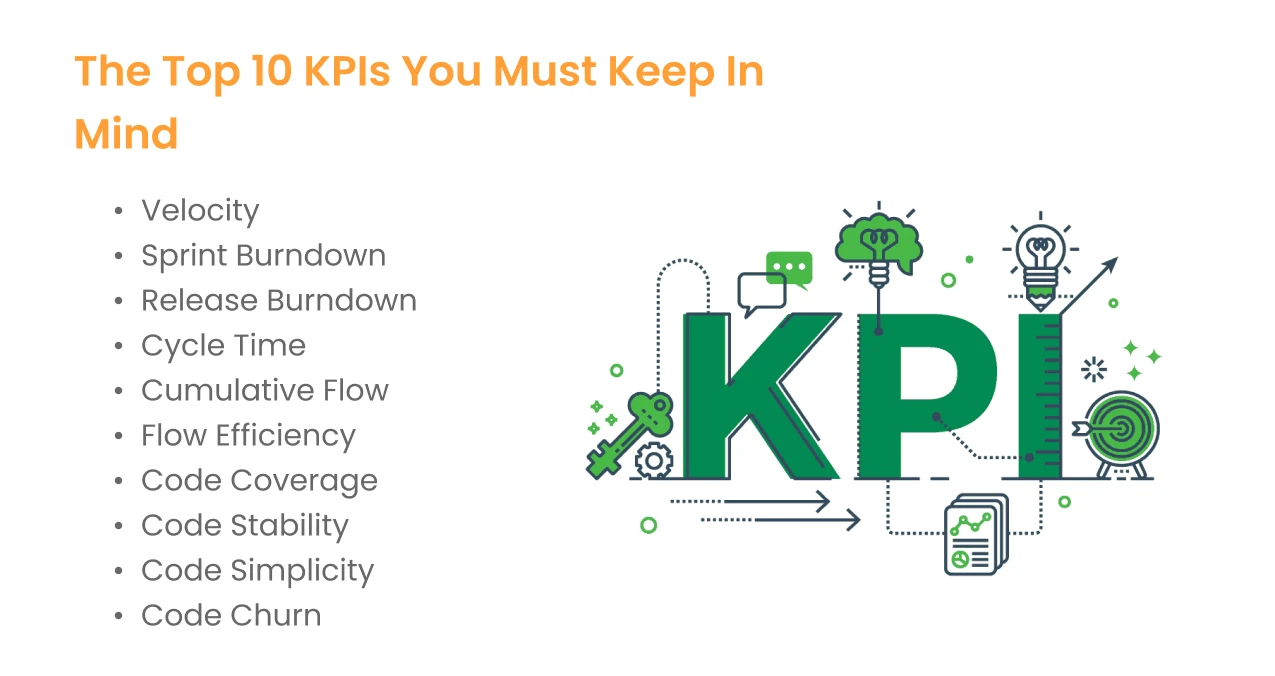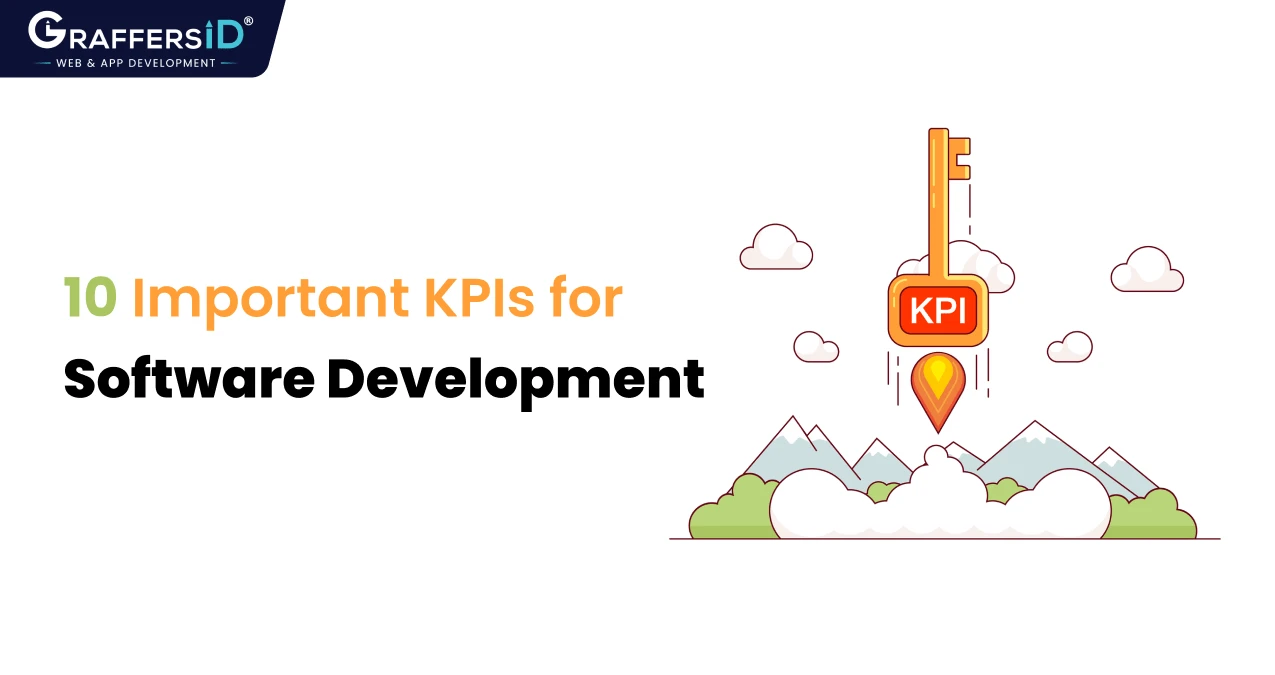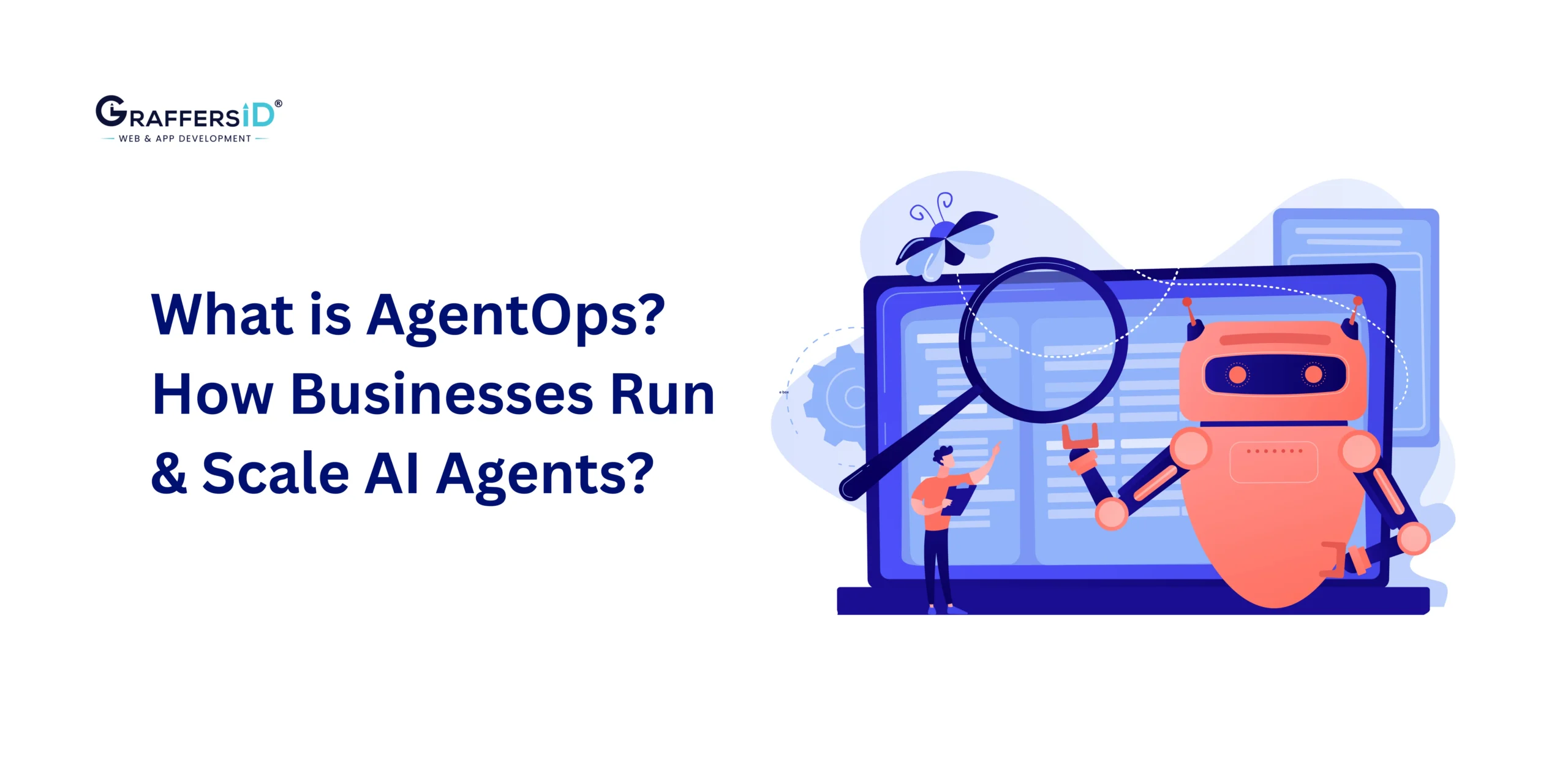Ready to establish your business goals? We say the key is measuring performance through software development. Did you know that people who write their measurable goals are 33% more likely to achieve those goals and establish outstanding performance?
And, when it comes to a technical work setting, key performance indicators (KPIs) come quite in handy. With high-rated priorities like meeting your client’s requirements and establishing a transparent network, software development can be a complex process. However, you can simplify things if you use KPIs to measure your goals.
So, if you are wondering what KPIs you need to keep in mind during the software development cycle, this article might be for you. Read on to explore the top 10 KPIs that are mandatory for a successful software development project.
Understanding KPIs
Key Performance Indicators, or KPIs, are quantifiable metrics that gauge the performance and progress of a project. In software development, they serve as essential tools to assess the efficiency, quality, and overall success of the development lifecycle.
An Overview Of Software Development KPI
Simply speaking, Key Performance Indicators (KPIs) are parameters to measure growth and figure out the goal-establishing process of your organization. However, when it comes to software development, KPIs simply help you determine the accuracy of the software and how well the software is in sync with your business objectives.
If you are planning to get into a software development cycle, it is essential to pick the right KPIs. However, it is extremely distressing to know that most businesses don’t always pick the right KPIs.
It’s important to understand that KPIs are general metrics that may not correspond to the main objective unless you modify them according to your needs.
Lastly, you can choose the right metric only when you combine the software quality with the interests of your business.
Why Are KPIs So Important In Software Development?
It’s true that to build outstanding software, you must consider a few KPIs to measure your goal achievement process. However, that’s not that. Picking the right KPIs can also help with identifying the problems faced by your software.
So, in addition to helping you build the right software, it also cancels any chances of errors. You can simply prioritize a metric that is showing errors and make your software development cycle error-free.
Besides this, KPIs also help with team productivity and recognizing collective efforts. In short, the faster the team can measure collective efforts in positive or negative outcomes, the faster it will be able to solve the drawbacks.
The Top 10 KPIs You Must Keep In Mind

Frankly speaking, when it comes to software development, the need to identify KPIs depends upon the goals and type of software you want to build. However, the following are the most common KPIs that can help you measure your growth and make the process more streamlined.
Velocity
Want to determine how realistic the goals are? Velocity means the amount of work completed by your team in a specific time. Mostly referred to as sprint, this specific time is usually associated with the time when particular tasks are required to be done.
You can measure the velocity in several ways. However, the most common method is through story points. This can help you calculate the amount of work put into software development. However, to estimate the story points, you must evaluate the size and time required to build that software.
Sprint Burndown
Now that you know about sprints, you must start by evaluating how much your team does work in a sprint. Sprint burndown is a metric that helps you do just that.
However, you must note that sprint burndown is different from velocity, as this metric helps you measure the actual effort put in a particular sprint, whereas velocity is simply an estimation.
Using this metric can be a great way to add a realistic touch to your goals, especially when the predictions might not go well with the actual performance.
Release Burndown
While measuring the efforts is an essential aspect of software development, you must also be in sync with the release progress. A release burndown is a metric that allows you to determine whether you’re behind, ahead, or on time with your release schedule.
Here’s an example for a better understanding. Businesses often use complex data to show their stakeholders the expected release of ROI. Likewise, this software metric can update the customers about signs of early release or possible delayed releases.
You must note that a release burndown chart is quite similar to a sprint burndown chart, where the x-axis represents sprints, and the y-axis means story points.
Cycle Time
While velocity and sprint burndown provide you with estimates and actual numbers of your team’s progress, cycle time is a software development KPI that measures the time taken to complete a specific task.
Developers might use cycle time charts to calculate the efficiency of the development process. Moreover, in addition to helping you quantify the performance, this KPI can also be used to set an estimate of future task completion and spot any inconsistencies that might obstruct the development process.
Cumulative Flow
Cumulative flow is another KPI that helps your software development team to demonstrate the tasks through visual diagrams.
The diagrams would include different colors representing different stages of the development process. For instance, a green color might mean ‘task completed’ while a yellow color might mean ‘task in progress.
This software metric can help you stabilize the development process and identify any drawbacks, thus, resulting in consistent output.
Flow Efficiency
This KPI helps you measure the ratio between active time and total time.
To set things straight, a software development cycle often comes with waiting periods where the developers cannot immediately move from one task to the next. Work in progress doesn’t always mean the actual work in progress. It can also represent the time standing still during these waiting periods.
One can calculate the flow efficiency of the development process by dividing the real active time by the total cycle time. This can also help you correlate the period with low efficiency to understand the causes behind any deficiencies.
Code Coverage
Here’s a fact: the higher the code coverage, the better.
Code coverage is another software development KPI used to measure code quality. Also known as test coverage, this metric determines the execution of source code.
Moreover, there are chances that the code executed by your team might have undetected bugs. Furthermore, the KPI ensures a higher coverage, so you would have to do less debugging.
Code Stability
Unlike code coverage, code stability is slightly tricky to measure. In short, stable code means that the software product requires few changes in the code thread.
During the development process, some developers might chart the code change frequency, while others might think of stability when it comes to downtime.
Code Simplicity
You can measure code simplicity through multiple metrics. One such metric for code simplicity is cyclomatic complexity, where the KPI measures the independent paths of a single code. In short, fewer paths would mean a simpler code. A simpler code always means it is easier to test and maintain, thus, making the development process more effective.
Code Churn
In addition to identifying multiple paths of a single code, code simplicity can also be calculated by determining how a code thread can change over time.
Code churn is a software KPI that measures the stability of the code by calculating the possibilities of how you would have to change the code over time. Simply put, if you are required to alter the code way too often to install a new feature in the software, the software would be high maintenance and would include even higher risk.
In short, it’s not something you would want to go for. Code churn improves the quality of your code by ensuring it is simple and adaptable to new changes.
Want to know About The Steps to Develop a Successful Software Startup from Scratch?
KPIs that help in assessing the performance of individual developers within a team
To effectively assess the performance of individual developers within a team, businesses rely on Key Performance Indicators (KPIs) tailored to measure various aspects of their work. Let’s delve into some KPIs that play a crucial role in evaluating and enhancing the performance of individual developers.
-
Code Quality and Efficiency Metrics:
- Code Review Feedback: This KPI measures how developers respond to feedback during code reviews. It reflects their ability to incorporate suggestions, improve code readability, and adhere to coding standards.
- Code Churn: Tracking the frequency of code changes can indicate productivity and stability. While some changes are necessary, excessive churn may point to inefficiencies or unclear project requirements.
- Code Coverage: Evaluating code coverage through unit tests showcases a developer’s commitment to writing robust, error-free code.
-
Task Completion and Timeliness:
- On-Time Delivery: This KPI assesses a developer’s ability to meet project deadlines consistently. It reflects time management skills, task prioritization, and overall project planning.
- Backlog Management: Tracking the resolution rate of assigned tasks helps gauge productivity and workload management. Lowering the backlog indicates efficient task handling.
-
Collaboration and Communication:
- Team Interaction: Assessing how effectively a developer collaborates with team members, contributes in meetings, and communicates progress fosters a cohesive team environment.
- Knowledge Sharing: Encouraging developers to share insights, solutions, and best practices can be quantified by measuring contributions to internal documentation or peer learning sessions.
-
Problem-Solving and Innovation:
- Bug Resolution Time: Rapid identification and resolution of bugs showcase a developer’s troubleshooting skills and attention to detail.
- Feature Implementation: Tracking the time taken to implement new features or functionalities reflects innovation, technical prowess, and adaptability to evolving project requirements.
-
Continuous Learning and Skill Development:
- Training Participation: Monitoring participation in workshops, online courses, or certifications demonstrates a developer’s commitment to continuous learning and skill enhancement.
- Technology Adoption: Assessing the adoption of new tools, frameworks, or coding practices indicates adaptability and readiness to embrace industry trends.
-
Feedback and Performance Reviews:
- 360-Degree Feedback: Incorporating feedback from peers, managers, and stakeholders provides a holistic view of a developer’s performance and areas for improvement.
- Regular Performance Reviews: Conducting periodic reviews allows for goal setting, performance discussions, and personalized development plans.
-
Client Satisfaction and Impact:
- Client Feedback: Gathering client feedback on deliverables, responsiveness, and quality of solutions helps measure the developer’s impact on client satisfaction and project success.
- Project Contribution: Recognizing significant contributions to project milestones, successful deployments, or innovative solutions showcases the developer’s value and impact on business outcomes.
Implementing these KPIs requires a balanced approach that considers individual strengths, team dynamics, and project requirements.
How to measure the effectiveness of software development using KPIs?
Ensuring the effectiveness of software development processes is crucial for delivering high-quality products and achieving business goals. Key Performance Indicators (KPIs) offer valuable insights into the efficiency and impact of software development initiatives. This comprehensive guide will walk you through the essential steps to measure the effectiveness of software development using KPIs.
Why Measure Software Development Effectiveness?
Understanding the reasons behind measuring software development effectiveness is crucial before delving into the specifics of KPIs. The primary objectives include:
- Quality Assurance: Ensuring the software meets quality standards and user expectations.
- Resource Utilization: Efficiently utilizing time, budget, and human resources.
- Project Management: Tracking progress, identifying delays, and managing risks effectively.
- Continuous Improvement: Identifying areas for enhancement in the development lifecycle.
Selecting the Right KPIs
Choosing the appropriate KPIs aligns with the unique goals and challenges of your software development process. Some relevant KPIs to consider include:
- Cycle Time: Measures the time taken to develop and deliver a feature.
- Lead Time: Evaluates the time between task creation and completion.
- Defect Density: Indicates the quality of the software by measuring defects per line of code.
- Code Churn: Tracks the volume of code changes over time.
- Customer Satisfaction: Collects user feedback to gauge satisfaction levels.
Implementing KPI Tracking
To effectively measure software development KPIs, follow these steps:
- Define Metrics: Clearly outline the metrics you intend to measure.
- Choose Tracking Tools: Utilize project management and data analytics tools.
- Automate Data Collection: Integrate tools to automatically collect KPI data.
- Set Baseline Values: Establish initial values for your chosen KPIs.
- Regularly Update Data: Continuously input and update data for accurate tracking.
Interpreting KPI Data
Once you’ve gathered KPI data, interpreting it correctly is essential:
- Identify Trends: Look for patterns and trends over specific time periods.
- Compare to Baseline: Measure current values against the established baseline.
- Analyze Deviations: Investigate any significant deviations from expected outcomes.
- Adjust Strategies: Use insights to refine development strategies.
Continuous Improvement Strategies
Based on the KPI data analysis, implement strategies for ongoing improvement:
- Process Refinement: Streamline workflows and remove bottlenecks.
- Training and Development: Enhance team skills through training programs.
- Feedback Integration: Utilize user feedback to drive product enhancements.
- Agile Adoption: Implement agile methodologies for flexibility and adaptability.
Competitor Research Insights
Before setting KPIs for your software development, it’s essential to conduct competitor research. Analyze the KPIs your competitors are tracking and identify trends or areas where you can outperform them. This analysis provides valuable insights into industry benchmarks and helps you set ambitious yet achievable KPIs.
In-Depth Analysis of Essential KPIs
-
Code Churn Rate
Code churn rate is a vital KPI that indicates the stability of your codebase. It’s calculated by dividing the lines of code changed by the total lines of code. A higher churn rate might signify underlying problems in development processes or inadequate testing protocols.
-
Lead Time to Changes
Lead time to changes measures the time it takes for a code change to go from development to production. A shorter lead time indicates efficient development and deployment processes. However, too short a lead time might compromise code quality.
-
Customer Support Response Time
In the software industry, prompt customer support is crucial. This KPI measures how quickly your customer support team addresses user queries or issues. A fast response time enhances customer satisfaction and portrays a customer-centric approach.
What are the challenges in implementing and using KPIs effectively in software development?
Common Challenges in Implementing KPIs
-
Defining Relevant KPIs
One of the initial hurdles in the effective use of KPIs is the challenge of identifying and defining relevant metrics. It’s crucial to align KPIs with the specific goals and objectives of the software project. Often, teams fall into the trap of using generic or popular KPIs that might not truly reflect the project’s success. The remedy lies in thorough research and collaboration among stakeholders to determine the most meaningful indicators.
-
Data Accuracy and Consistency
Inaccurate or inconsistent data can severely impact the reliability of KPIs. Garbage in, garbage out – this saying holds true for KPIs as well. If the data feeding into the metrics is flawed, the resulting insights will be unreliable. This challenge calls for stringent data collection processes, regular audits, and validation mechanisms to ensure the integrity of the metrics.
-
Setting Achievable Targets
Ambitious targets might sound motivating, but they can lead to demotivation and frustration if they’re unattainable. Unrealistic targets not only hinder the team’s morale but also distort the true picture of progress. Striking the right balance between ambitious and achievable targets is a challenge that requires a deep understanding of the project’s complexities and the team’s capabilities.
Challenges in Using KPIs Effectively
-
Overemphasis on Quantitative Metrics
While quantitative metrics provide valuable insights, solely relying on them can be misleading. The quality and user experience of the software might suffer if the focus is solely on quantitative KPIs. To overcome this challenge, it’s essential to complement quantitative metrics with qualitative assessments, such as user feedback and usability testing.
-
Ignoring Qualitative Aspects
On the flip side, ignoring quantitative metrics altogether in favor of qualitative aspects is also a pitfall. Qualitative data, such as user satisfaction and feedback, provides a subjective view of the software’s performance. However, a balance must be maintained, as relying solely on qualitative data might lead to overlooking critical performance issues.
-
Communication Breakdown
Efficient communication is the backbone of successful KPI utilization. Often, the technical nature of KPIs can lead to misinterpretation, creating a communication gap between developers, managers, and stakeholders. Bridging this gap requires translating technical metrics into comprehensible insights and fostering open lines of communication.
Strategies to Overcome KPI Implementation Challenges
-
Involvement of Stakeholders
To ensure that KPIs align with the project’s goals, involving stakeholders from the outset is paramount. Their insights and perspectives can shed light on what truly matters to the project’s success. Regular meetings and discussions can help in refining KPIs to make them more relevant and effective.
-
Utilizing Advanced Tools
Modern software development benefits from a plethora of tools designed to streamline KPI tracking and analysis. Leveraging advanced software analytics tools can alleviate data accuracy and consistency challenges. These tools not only automate data collection but also provide in-depth visualizations for better insights.
-
Continuous Monitoring and Adaptation
KPIs are not set in stone; they should evolve alongside the project. Regular monitoring allows teams to identify trends and anomalies early on. If a certain KPI proves ineffective or irrelevant, it should be replaced or modified. Flexibility in KPI selection and adaptation is key to addressing challenges in their implementation.
Strategies for Using KPIs Effectively
-
Balanced Approach to Metrics
A holistic approach involves balancing quantitative metrics with qualitative assessments. While quantitative data provides numeric insights, qualitative data adds the human element, offering a comprehensive view of the software’s performance. Striking this balance ensures that all aspects of the software’s success are considered.
-
Regular Performance Reviews
Scheduled performance reviews are invaluable in using KPIs effectively. These reviews offer the opportunity to analyze trends, discuss challenges, and make informed decisions based on the insights provided by the metrics. They also facilitate open discussions and prompt actions to address any issues that arise.
-
Transparent Communication
Clear and transparent communication is the glue that holds KPI utilization together. Teams must ensure that insights derived from KPIs are shared openly with all stakeholders. This transparency fosters a sense of ownership, encourages collaboration, and enables timely adjustments if deviations from targets occur.
Wrapping It Up
Stating again, a different development process requires you to determine different KPIs. However, the ones stated above are indispensable metrics that not only make the entire process easy but also ensure higher productivity. To know more, you can get in touch with GraffersID, the best offshore software development center, to streamline your software development process and meet targets easily.




